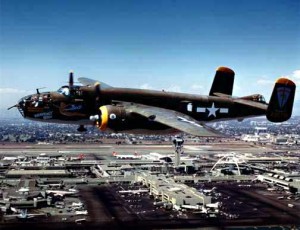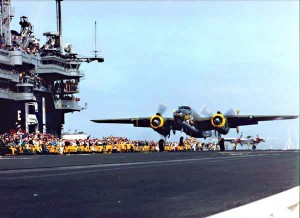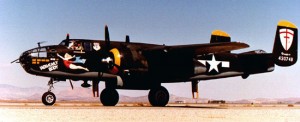A personal account by a participant of the raid continues:
 After we got settled in Columbus, my squadron commander called us all together. He told us that an awfully hazardous mission was being planned, and then he asked for volunteers. There were some of the guys that did not step forward, but I was one of the ones that did. My co-pilot was shocked.
He said, “You can’t volunteer, Mac! You’re married, and you and Aggie are expecting a baby soon. Don’t do it!”
After we got settled in Columbus, my squadron commander called us all together. He told us that an awfully hazardous mission was being planned, and then he asked for volunteers. There were some of the guys that did not step forward, but I was one of the ones that did. My co-pilot was shocked.
He said, “You can’t volunteer, Mac! You’re married, and you and Aggie are expecting a baby soon. Don’t do it!”
I told him, “I got into the Air Force to do what I can, and Aggie understands how I feel. The war won’t be easy for any of us.”
We that volunteered were transferred to Eglin Field near Valparaiso, Florida in late February. When we all got together, there were about 140 of us volunteers, and we were told that we were now part of the “Special B-25 Project.” We set about our training, but none of us knew what it was all about. We were ordered not to talk about it, not even to our wives.
In early March, we were all called in for a briefing, and gathered together in a big building on the base. Somebody said that the fellow who is head of this thing is coming to talk to us, and in walks Lieutenant Colonel Jimmy Doolittle. He was already an aviation legend, and there he stood right in front of us. I was truly amazed just to meet him.
Colonel Doolittle explained that this mission would be extremely dangerous, and that only volunteers could take part. He said that he could not tell us where we were going, but he could say that some of us would not be coming back. There was a silent pause. You could have heard a pin drop. Then Doolittle said that anyone of us could withdraw now, and that no one would criticize us for this decision. No one backed out!
From the outset, all volunteers worked from the early morning hours until well after sunset. All excess weight was stripped from the planes and extra gas tanks were added. The lower gun turret was removed, the heavy liaison radio was removed, and then the tail guns were taken out and more gas tanks were put aboard. We extended the range of that plane from 1000 miles out to 2500 miles.
Then I was assigned my crew. There was Richard Knobloch the co-pilot, Clayton  Campbell the navigator, Robert Bourgeous the bombardier, Adam Williams the flight engineer and gunner, and me, Mac McElroy the pilot. Over the coming days, I came to respect them a lot. They were a swell bunch of guys, just regular all-American boys.
We got a few ideas from the training as to what type of mission that we had signed on for. A Navy pilot had joined our group to coach us on short takeoffs and also in shipboard etiquette. We began our short takeoff practice, taking off with first a light load, then a normal load, and finally overloaded up to 31,000 lbs.
Campbell the navigator, Robert Bourgeous the bombardier, Adam Williams the flight engineer and gunner, and me, Mac McElroy the pilot. Over the coming days, I came to respect them a lot. They were a swell bunch of guys, just regular all-American boys.
We got a few ideas from the training as to what type of mission that we had signed on for. A Navy pilot had joined our group to coach us on short takeoffs and also in shipboard etiquette. We began our short takeoff practice, taking off with first a light load, then a normal load, and finally overloaded up to 31,000 lbs.
The shortest possible take-off was obtained with flaps full down, stabilizer set three-fourths, tail heavy, full power against the brakes and releasing the brakes simultaneously as the engine revved up to max power. We pulled back gradually on the stick and the airplane left the ground with the tail skid about one foot from the runway. It was a very unnatural and scary way to get airborne! I could hardly believe it myself, the first time as I took off with a full gas load and dummy bombs within just 700 feet of runway in a near-stall condition. We were, for all practical purposes, a slow-flying gasoline bomb!
In addition to take-off practice, we refined our skills in day and night navigation, gunnery, bombing, and low level flying. We made cross country flights at tree-top level, night flights and navigational flights over the Gulf of Mexico without the use of a radio. After we started that short-field takeoff routine, we had some pretty fancy competition between the crews. I think that one crew got it down to about 300 feet on a hot day.
 We were told that only the best crews would actually go on the mission, and the rest would be held in reserve. One crew did stall on takeoff, slipped back to the ground and busted up their landing gear. They were eliminated from the mission. Doolittle emphasized again and again the extreme danger of this operation, and made it clear that anyone of us who so desired could drop out with no questions asked. No one did.
We were told that only the best crews would actually go on the mission, and the rest would be held in reserve. One crew did stall on takeoff, slipped back to the ground and busted up their landing gear. They were eliminated from the mission. Doolittle emphasized again and again the extreme danger of this operation, and made it clear that anyone of us who so desired could drop out with no questions asked. No one did.
On one of our cross country flights, we landed at Barksdale Field in Shreveport, and I was able to catch a bus over to Longview to see Aggie. We had a few hours together, and then we had to say our goodbyes. I told her I hoped to be back in time for the baby’s birth, but I couldn’t tell her where I was going. As I walked away, I turned and walked backwards for a ways, taking one last look at my beautiful pregnant Aggie.
Please visit again soon for Doolittle Raid Part 3.


